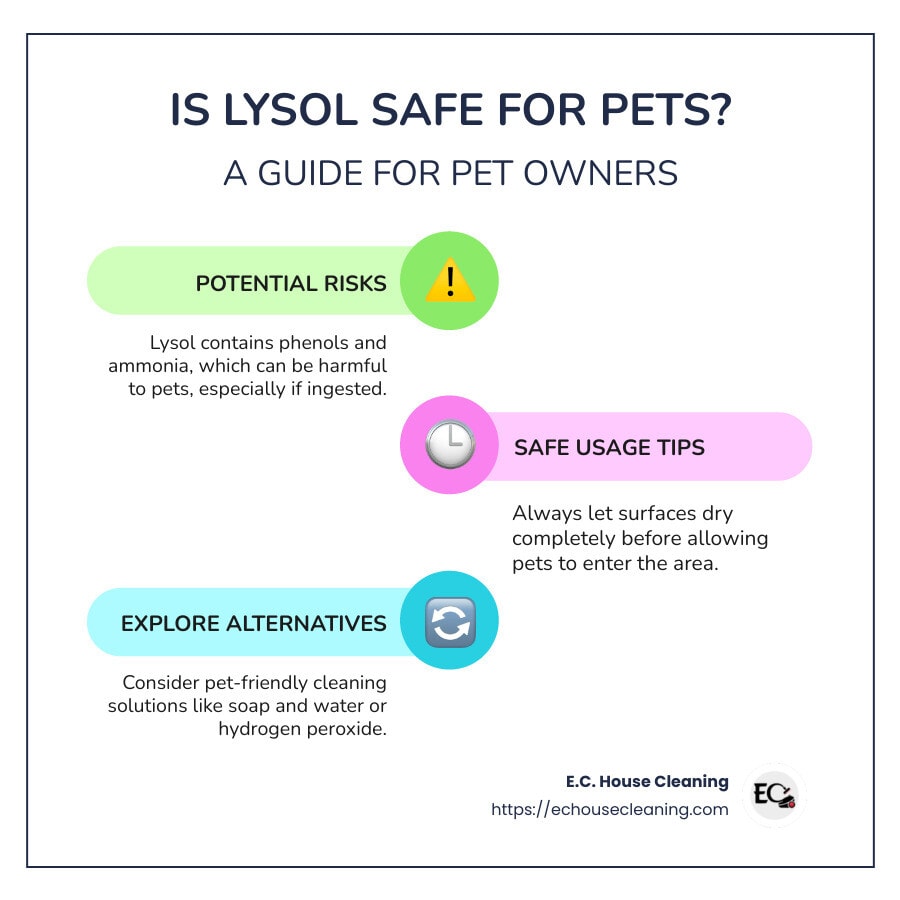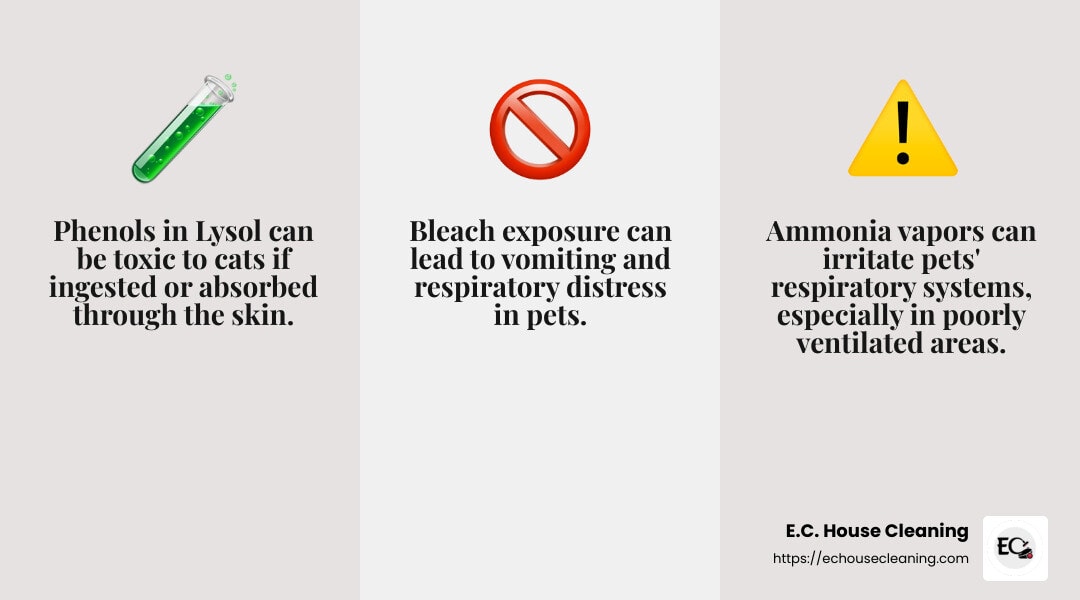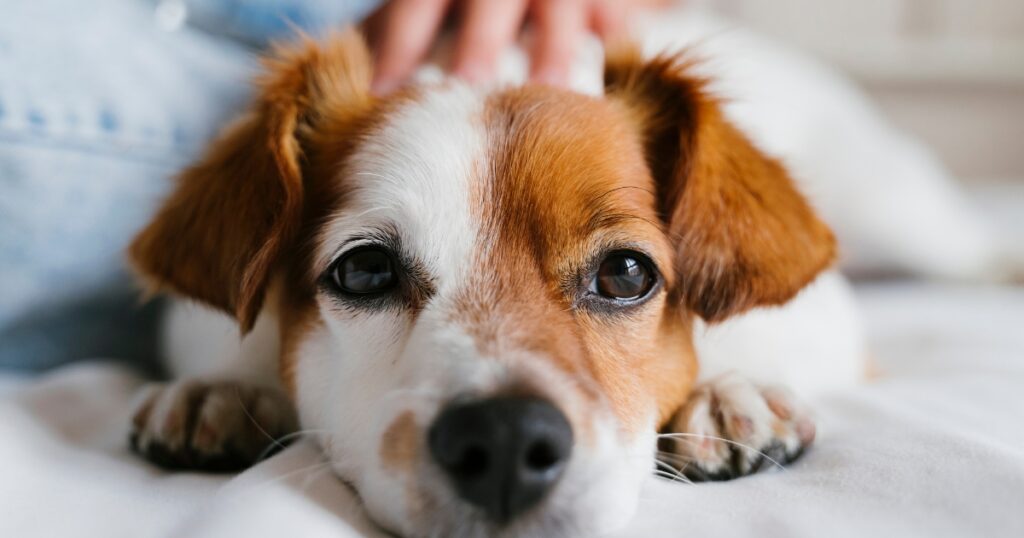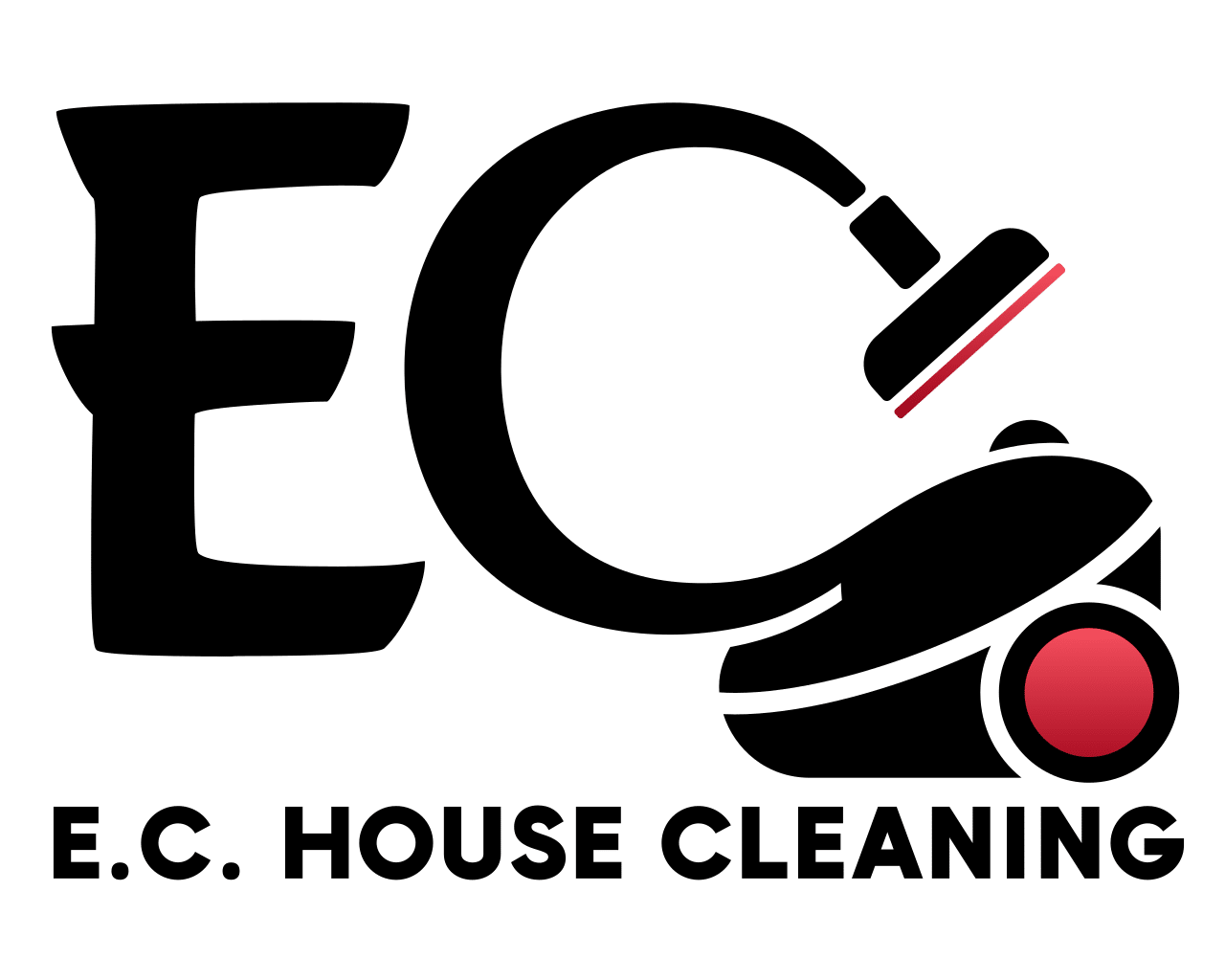Is Lysol safe for pets? This is a common question among pet owners who strive to maintain a clean home without jeopardizing the safety of their furry friends. In brief, while Lysol is effective at disinfecting, certain active ingredients might pose a health risk to pets if not used with caution.
Specifically, phenols and other chemicals found in some Lysol products can be toxic to animals, particularly if ingested or absorbed through the skin.
- Caution is key: Always use Lysol products as directed, allowing surfaces to dry completely before allowing pets access.
- Keep pets away: Ensure pets are not in the room during cleaning.
- Explore alternatives: Consider pet-safe cleaning products and homemade solutions to maintain a clean and safe environment.
At E.C. House Cleaning, we understand the importance of a pristine space that doesn’t compromise the health of your pets. I’m Eliana Coca, and with over 20 years of experience, I have dedicated myself to ensuring that our cleaning practices are both effective and safe, especially when considering the question is lysol safe for pets.
Our commitment is to provide trustworthy and eco-friendly cleaning solutions that keep both your home and pets safe.

Table of Contents
Understanding Lysol and Its Ingredients
Lysol is a popular household cleaner known for its ability to kill germs and eliminate odors. However, when it comes to pet safety, understanding its ingredients is crucial. Is Lysol safe for pets?
Key Ingredients in Lysol
- Phenols: These are toxic ingredients often found in disinfectants like Lysol. While effective against bacteria and viruses, phenols can be hazardous to pets, especially cats. Cats have difficulty metabolizing phenols, which can lead to health issues if they are exposed to these chemicals.
- Ammonia: Known for its strong cleaning power, ammonia is another toxic ingredient in some Lysol products. Although effective, ammonia can pose respiratory risks to pets if inhaled, especially in poorly ventilated areas.
- Bleach: Commonly used for its disinfecting properties, bleach is a toxic ingredient present in some Lysol formulations. While bleach can effectively kill germs, it can be dangerous for pets if ingested or if they come into contact with surfaces that are still wet from cleaning.
Why These Ingredients Matter
- Understanding the impact of these household cleaning products on pets is crucial for their safety. Phenols can cause liver damage in cats. Dogs, while more resilient, can also suffer from skin irritation or gastrointestinal issues if they ingest or come into contact with phenols.
- Ammonia vapors can irritate the eyes, nose, and throat of both humans and animals. For pets, who are closer to the ground and more likely to sniff surfaces, this can be particularly troublesome.
- Bleach exposure can lead to vomiting, drooling, or respiratory distress in pets. Even a small amount of bleach can be harmful if not used properly.
Safe Use of Lysol Around Pets
- Proper Ventilation: Ensure the area is well-ventilated and follow the manufacturer’s instructions when using Lysol. This helps to minimize the inhalation risks associated with ammonia and bleach.
- Allow to Dry: Always let surfaces dry completely before allowing pets to come into contact with them. This reduces the risk of ingestion or skin contact with harmful chemicals.
- Keep Pets Away: During cleaning, keep pets in a separate room to avoid accidental exposure.
Understanding these ingredients and their effects on pets is key to answering the question, is lysol safe for pets? By using Lysol products correctly and taking precautions, you can maintain a clean home without compromising your pet’s health.

Next, we’ll explore how Lysol specifically affects dogs and cats, as well as the symptoms of exposure.
The Risks of Using Lysol Around Pets
Using Lysol around pets can pose significant risks to their health and well-being. Lysol products contain harsh chemicals, such as benzalkonium chloride and quaternary ammonium compounds, which can be toxic to pets if ingested, inhaled, or if they come into contact with their skin or eyes.
Pet parents should be aware of the potential dangers associated with using Lysol around their pets and take necessary precautions to minimize the risks.
Some of the risks associated with using Lysol around pets include:
- Ingestion: If pets ingest Lysol, it can cause vomiting, diarrhea, abdominal pain, and even organ damage. This is particularly concerning for curious pets who might lick surfaces or containers.
- Inhalation: Inhaling Lysol fumes can cause respiratory problems, such as coughing, sneezing, and difficulty breathing. Pets, especially those with pre-existing respiratory conditions, are at higher risk.
- Skin and eye irritation: Lysol can cause skin and eye irritation, including redness, itching, and burning. Pets with sensitive skin or those prone to allergies may experience more severe reactions.
Understanding these risks is crucial for pet parents who want to maintain a clean home without compromising their pets’ health. By being aware of the potential dangers, you can take steps to protect your furry friends from harmful exposure.
Is Lysol Safe for Pets?

When asking, is Lysol safe for pets, it’s important to consider the potential risks and how to minimize them. While Lysol can effectively kill germs, its ingredients, such as phenols, ammonia, and bleach, can pose dangers to pets if used improperly.
How Lysol Affects Dogs and Cats
Toxicity to Pets: Both dogs and cats can be affected by Lysol’s ingredients. Cats, in particular, are sensitive to phenols, which they cannot metabolize effectively.
This can lead to severe liver damage. Dogs are not immune either; they can experience skin irritation or digestive issues if they ingest or come into contact with phenols.
Exposure Risks: Pets are naturally curious and may sniff or lick freshly cleaned surfaces. This behavior increases the risk of exposure to harmful chemicals. Inhalation of ammonia vapors can irritate their respiratory systems, and contact with wet surfaces can lead to skin and eye irritation.
Ingestion Risks: If pets ingest Lysol, they may show symptoms such as vomiting, diarrhea, drooling, or difficulty breathing. In severe cases, ingestion can lead to more serious health issues, requiring immediate veterinary attention.
Safe Usage of Lysol Around Pets
To ensure safe use of Lysol around pets, follow these guidelines:
Proper Application: Always adhere to the manufacturer’s instructions for using Lysol products. This includes using the correct dilution and application methods to minimize risks.
Drying Surfaces: After cleaning, allow surfaces to dry completely before letting pets back into the area. This reduces the chance of them coming into contact with wet chemicals, which can be harmful if licked or absorbed through the skin.
Pet-Free Cleaning: Whenever possible, keep pets out of the room while cleaning. This simple step helps prevent accidental exposure and ingestion.
By understanding these risks and taking necessary precautions, you can use Lysol effectively and keep your pets safe. The key is to manage exposure and ensure that your cleaning practices do not compromise the well-being of your furry friends. Consulting with a professional in veterinary medicine can provide additional guidance on safe cleaning practices around pets.
Next, we’ll discuss alternatives to Lysol for pet-safe cleaning, offering solutions that maintain cleanliness while ensuring your pet’s safety.
What to Do if Your Pet Is Exposed to Lysol
If your pet is exposed to Lysol, it is essential to act quickly and seek veterinary attention if necessary. Here are some steps you can take to ensure your pet’s safety:
- Ingestion: If your pet ingests Lysol, contact your veterinarian or a pet poison hotline immediately. Provide them with information about the product and the amount ingested.
- Inhalation: If your pet inhales Lysol fumes, move them to a well-ventilated area and provide fresh air. Monitor their breathing and seek veterinary attention if they show signs of respiratory distress.
- Skin or eye contact: If your pet comes into contact with Lysol on their skin or eyes, wash the affected area with plenty of water. Use a gentle, pet-safe shampoo if necessary, and seek veterinary attention if irritation persists.
It is also important to note that some pets may be more susceptible to the effects of Lysol than others, such as older pets, pets with pre-existing medical conditions, and pets that are pregnant or nursing. Always keep an eye on your pet’s behavior and health, and seek veterinary attention if you notice any signs of illness or distress.
To minimize the risks associated with using Lysol around pets, consider the following precautions:
- Use pet-safe cleaning products: Opt for cleaning products specifically designed to be safe for pets. These products are formulated without harsh chemicals that can harm your furry friends.
- Secure storage: Keep Lysol products out of reach of pets and in a secure location. This prevents accidental ingestion or contact.
- Follow instructions: Always follow the manufacturer’s instructions for use and take necessary precautions to avoid exposure. Ensure surfaces dry completely before allowing pets back into the area.
- Natural alternatives: Consider using natural ingredients, such as baking soda and hydrogen peroxide, as alternatives to Lysol. These options can effectively clean and disinfect without posing a risk to your pets.
By taking these precautions and being aware of the risks associated with using Lysol around pets, pet parents can help keep their pets safe and healthy.
Alternatives to Lysol for Pet-Safe Cleaning

When it comes to keeping your home clean and safe for your pets, you don’t have to rely solely on products like Lysol. There are effective alternatives that can help you maintain a hygienic environment without risking your pet’s health. Let’s explore some of these options:
Soap and Water
It might seem simple, but soap and water is one of the safest and most effective cleaning solutions available. This basic combination can effectively remove dirt, grime, and some germs from surfaces. It’s free from harsh chemicals, making it a pet-friendly option.
Just like washing your hands, using soap and water on surfaces can help break down and wash away contaminants. Plus, it’s readily available and budget-friendly.
Hydrogen Peroxide
Hydrogen peroxide is another excellent alternative. This eco-friendly solution is known for its disinfecting properties. It can kill bacteria, fungi, and viruses, making it a powerful cleaner. To use hydrogen peroxide, mix it with an equal part of water and apply it to the surface you want to clean.
Let it sit for a few minutes before wiping it away. While hydrogen peroxide is generally safe, you should keep pets away from freshly cleaned areas until they’re dry.
Clorox Free & Clear
If you’re looking for a store-bought option, consider Clorox Free & Clear. This product is designed to be free from harsh chemicals and fragrances, making it a safer choice for homes with pets.
It effectively cleans surfaces without leaving behind harmful residues. Always follow the manufacturer’s instructions and ensure that surfaces are dry before allowing pets to access the area.
By using these alternatives, you can keep your home clean and your pets safe. Each option offers a way to maintain hygiene without introducing unnecessary risks to your furry friends.
Conclusion
Ensuring pet safety while maintaining a clean home is a delicate balance. As pet owners, we want our living spaces to be free from germs and odors, but not at the expense of our furry friends’ health. Understanding the products we use, like Lysol, and their potential risks is essential.
While Lysol can be effective, it requires careful application and adherence to guidelines to minimize exposure risks. Cleaning guidelines are crucial to keeping your pets safe.
Always follow product instructions, ensure surfaces dry completely, and keep pets away from freshly cleaned areas. Opting for pet-safe cleaning alternatives, like eco-friendly solutions, can further reduce risks.
These products are designed to be non-toxic and environmentally friendly, offering peace of mind while effectively cleaning your home.
Contact us today at E.C. House Cleaning, we are committed to providing a safe and clean environment for both you and your pets. Our use of eco-friendly, pet-safe products ensures that we meet the highest standards of cleanliness without compromising your pets’ well-being. We understand the importance of maintaining a healthy home for all family members, including the furry ones.
For more information on pet-safe cleaning solutions, visit our eco-friendly cleaning products for pets page. Here, you can explore our range of services custom to create a safer, cleaner home for you and your pets.
By choosing the right products and following safe cleaning practices, you can enjoy a spotless home without worrying about your pet’s safety.
Frequently Asked Questions about Lysol and Pets
Is Lysol Safe After It Dries?
A common question pet owners ask is whether Lysol is safe for pets once it has dried. In general, Lysol products are safer after they have completely dried because the chemicals have had time to dissipate. However, it’s crucial to ensure that the area is well-ventilated during and after cleaning to minimize any lingering fumes.
Always follow the manufacturer’s instructions for drying times and keep pets away from treated areas until they are dry to the touch.
Can You Spray a Dog Bed with Lysol?
While you might be tempted to use Lysol on your dog’s bed to eliminate odors, it’s important to exercise caution. Lysol Pet Solutions offers an odor eliminator specially formulated for use around pet areas. This product is designed to neutralize tough odors on fabrics and surfaces, including pet beds.
However, always remove your pets from the area before applying the product and allow it to dry completely before letting them return. This reduces the risk of exposure to potentially harmful chemicals.
What Are Signs of Lysol Poisoning in Pets?
If a pet comes into contact with Lysol, either through ingestion or skin exposure, they may show signs of poisoning. Symptoms of Lysol poisoning can include drooling, vomiting, difficulty breathing, and irritation in the mouth or throat. In severe cases, it can lead to chemical burns.
If you suspect your pet has been exposed to Lysol, it’s crucial to contact your veterinarian immediately for advice. They can provide guidance on the best course of action and help ensure your pet receives the necessary care.
By understanding these key points, you can make informed decisions about using Lysol and other cleaning products in your home, keeping your pets safe and healthy.
Our Content
All content is written by E.C. House Cleaning’s professional cleaning company. We put our expertise in house cleaning services into each piece of content, focusing on providing valuable, accurate, and relevant information. With over 20 years of deep, full cleaning service industry experience in the Massachusetts and Boston area with a proven track record of pet-friendly house cleaning services in Massachusetts, commercial office cleaning Boston, and trust for customers as signaled by our hundreds of 5-star reviews, E.C. House Cleaning is an authority on residential and commercial cleaning services.
